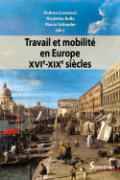In the past two decades, labour and mobility have become major analytical paradigms in the humanities and the social sciences. They now occupy a strategic position in scholarly debates that focus particularly on the structure of the labour market in global economies and the increase of migration flows across the world. The historical analysis of these transformations has led to insightful perspectives. Historians, anthropologists, geographers, and social scientists have challenged the assumption that major shifts in labour relations in global labour markets – such as labour precariousness and flexibility – have emerged with the rise of the «post-industrial» society and «neoliberal globalisation» in the second half of the twentieth century. Historians of migration have also shifted the scope of their analysis from late-nineteenth and early-twentieth century transatlantic migrations to migratory movements in previous epochs of human history. This approach has significantly reconceptualized the historical dimension of migrations, including by defining labour mobility as a resource rather than a necessity.
The book Travail et mobilité en Europe. XVIe–XIXe siècles offers useful insights into these research strategies. The main intent of the book is to reconsider mobility and labour in light of the social and economic frameworks of preindustrial societies and to explore both as resources at the disposal of different historical actors. To this purpose, the nine essays that comprise the volume shed light on different labour contexts that incorporate various features of spatial and professional mobility. The focus is mostly on rural and urban labour markets in north-western Italy, France, and the Mediterranean. They also address Alpine migrations, and mobility patterns in commodity chains in Spain and Italy. The exhaustive source-based analysis in each case study gives insight into the intensity of spatial and professional mobility in preindustrial Europe. The major contribution of the volume is to reappraise a long-established approach that linked regulated and (mostly) legal work to professional and geographical stability. The essays by Beatrice Zucca Micheletto, Aurélien Gras, Marco Schnyder, Francesca Chiesi Ermotti, and Richard Flamein explore the variety of ways through which the labour experience and economic viability of diverse members of early modern society – artisans, labourers, families, merchants – was based on preserving chances to migrate. To do so, early modern workers adopted various forms of individual and network-based strategies. For example, Swiss and Grisons migrants engaged in intermediary forms of spatial mobility and social integration – called «voluntary imperfect integration» here – up until the last decades of the eighteenth century. Both spatial and professional mobility reflected labourers’ strategies in early modern urban agglomerations. Zucca Micheletto, for example, examines how pluriactivity became a resource for many urban workers particularly to avert labour precariousness and economic uncertainty.
The skills and abilities of workers significantly influenced the opportunities migrants had to participate in the labour market abroad. From wool weavers and carders in sixteenth- and seventeenth-century Huéscar and Padova (Andrea Caracausi & Rafael M. Giron-Pascual) to the Parisian bankers in eighteenth-century France (Richard Flamein), the authors investigate to what extent skills could be used as bargaining chips to aid in social and economic integration. Some case studies do not much investigate the impact of migrants’ skills on the social and economic transformations of local manufacture, but others demonstrate how migrant workers and merchant-entrepreneurs used not just their skills and craftsmanship to access the labour market but also their reputation (Romain Grancher), their social prestige (Francesca Chiesi Ermotti), and their ability to build social relations (Aurélien Gras).
The authors also provide insight into the recent debate on the role of economic institutions in fostering and regulating labour mobility in the early modern period. On the one hand, they reappraise the role of the state by analysing the multi-layered migration policies shaped by intermediary actors, including merchant-entrepreneurs, ambassadors, and local authorities. It underscores the fact that state action was based on economic and social necessities, including safeguarding local employment, regulating the legal and financial situations of migrants, and trying to curb vagrancy, rather than on consolidated and uniform policies about labour mobility. On the other hand, the book contributions challenge the idea that work in urban agglomerations was performed exclusively in guilds or other forms of organized trade. By moving beyond the dichotomy of legal and illegal work, the essays demonstrate the importance of labour performed outside the control of institutions in early modern societies (Zucca Micheletto; Aurélien Gras). In her essay on the building trades in eighteenth-century Piedmont, Nicoletta Rolla also shows how the degree of worker mobility was imbricated with devotional ceremonies carried out by guilds and brotherhoods, reflecting workers’ opposition to employer control over their spatial mobility.
Still, both policy makers and employers had a common strategic interest: to synchronize the availability of the workforce with production needs. In order to do so, merchant-entrepreneurs, guilds, and brotherhoods used social and economic instruments including higher wages, health-care benefits, and employment contracts to bind migrant workers to specific activities (Andrea Caracausi & Rafael M. Giron-Pasqual). In some cases, wages were paid after the end of the employment period and, combined with oral and ambiguous employment contracts, reflected the entrepreneurs’ efforts to control workers’ mobility (Nicoletta Rolla). However, few of the essays investigate the structure(s) of wages in the various labour contexts. Overall, one gains useful insights into the intertwined relations between policy makers’ efforts to immobilize the workforce and the degree of autonomy workers sought to obtain in specific labour relations.
Travail et mobilité en Europe XVIe–XIXe siècles offers intriguing perspectives for understanding labour mobility in the early modern period. By adopting innovative methodological approaches, the volume enriches our understanding of specific mobility patterns in preindustrial Europe, using wide-ranging historical analyses, in diverse labour contexts, that are based on substantial archival sources. One can only hope that it will find many readers beyond the French-speaking readership.
Zitierweise:
Marcon, Gabriele: Rezension zu: Caracausi, Andrea; Rolla, Nicoletta; Schnyder, Marco (éds.): Travail et mobilité en Europe. XVIe–XIXe siècles, Villeneuve d’Ascq 2018. Zuerst erschienen in: Schweizerische Zeitschrift für Geschichte 71 (2), 2021, S. 368-370. Online: <https://doi.org/10.24894/2296-6013.00088>.
